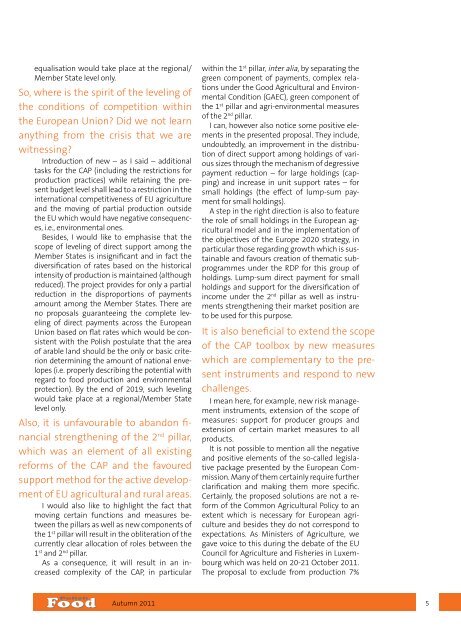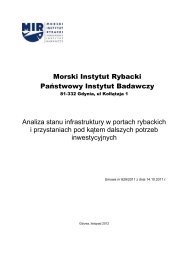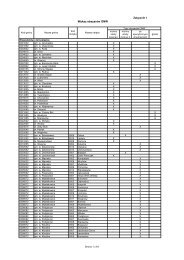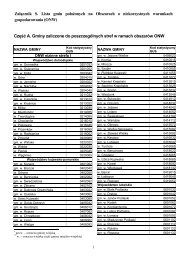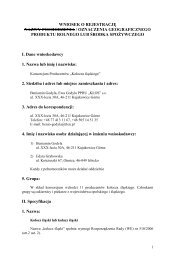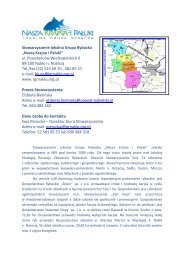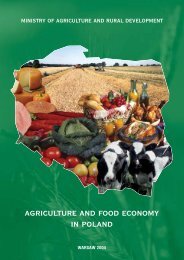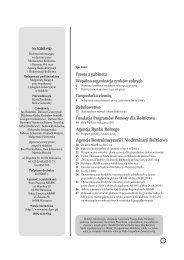download file
download file
download file
Create successful ePaper yourself
Turn your PDF publications into a flip-book with our unique Google optimized e-Paper software.
equalisation would take place at the regional/<br />
Member State level only.<br />
So, where is the spirit of the leveling of<br />
the conditions of competition within<br />
the European Union? Did we not learn<br />
anything from the crisis that we are<br />
witnessing?<br />
Introduction of new – as I said – additional<br />
tasks for the CAP (including the restrictions for<br />
production practices) while retaining the present<br />
budget level shall lead to a restriction in the<br />
international competitiveness of EU agriculture<br />
and the moving of partial production outside<br />
the EU which would have negative consequences,<br />
i.e., environmental ones.<br />
Besides, I would like to emphasise that the<br />
scope of leveling of direct support among the<br />
Member States is insignificant and in fact the<br />
diversification of rates based on the historical<br />
intensity of production is maintained (although<br />
reduced). The project provides for only a partial<br />
reduction in the disproportions of payments<br />
amount among the Member States. There are<br />
no proposals guaranteeing the complete leveling<br />
of direct payments across the European<br />
Union based on flat rates which would be consistent<br />
with the Polish postulate that the area<br />
of arable land should be the only or basic criterion<br />
determining the amount of national envelopes<br />
(i.e. properly describing the potential with<br />
regard to food production and environmental<br />
protection). By the end of 2019, such leveling<br />
would take place at a regional/Member State<br />
level only.<br />
Also, it is unfavourable to abandon financial<br />
strengthening of the 2 nd pillar,<br />
which was an element of all existing<br />
reforms of the CAP and the favoured<br />
support method for the active development<br />
of EU agricultural and rural areas.<br />
I would also like to highlight the fact that<br />
moving certain functions and measures between<br />
the pillars as well as new components of<br />
the 1 st pillar will result in the obliteration of the<br />
currently clear allocation of roles between the<br />
1 st and 2 nd pillar.<br />
As a consequence, it will result in an increased<br />
complexity of the CAP, in particular<br />
within the 1 st pillar, inter alia, by separating the<br />
green component of payments, complex relations<br />
under the Good Agricultural and Environmental<br />
Condition (GAEC), green component of<br />
the 1 st pillar and agri-environmental measures<br />
of the 2 nd pillar.<br />
I can, however also notice some positive elements<br />
in the presented proposal. They include,<br />
undoubtedly, an improvement in the distribution<br />
of direct support among holdings of various<br />
sizes through the mechanism of degressive<br />
payment reduction – for large holdings (capping)<br />
and increase in unit support rates – for<br />
small holdings (the effect of lump-sum payment<br />
for small holdings).<br />
A step in the right direction is also to feature<br />
the role of small holdings in the European agricultural<br />
model and in the implementation of<br />
the objectives of the Europe 2020 strategy, in<br />
particular those regarding growth which is sustainable<br />
and favours creation of thematic subprogrammes<br />
under the RDP for this group of<br />
holdings. Lump-sum direct payment for small<br />
holdings and support for the diversification of<br />
income under the 2 nd pillar as well as instruments<br />
strengthening their market position are<br />
to be used for this purpose.<br />
It is also beneficial to extend the scope<br />
of the CAP toolbox by new measures<br />
which are complementary to the present<br />
instruments and respond to new<br />
challenges.<br />
I mean here, for example, new risk management<br />
instruments, extension of the scope of<br />
measures: support for producer groups and<br />
extension of certain market measures to all<br />
products.<br />
It is not possible to mention all the negative<br />
and positive elements of the so-called legislative<br />
package presented by the European Commission.<br />
Many of them certainly require further<br />
clarification and making them more specific.<br />
Certainly, the proposed solutions are not a reform<br />
of the Common Agricultural Policy to an<br />
extent which is necessary for European agriculture<br />
and besides they do not correspond to<br />
expectations. As Ministers of Agriculture, we<br />
gave voice to this during the debate of the EU<br />
Council for Agriculture and Fisheries in Luxembourg<br />
which was held on 20-21 October 2011.<br />
The proposal to exclude from production 7%<br />
Autumn 2011 5


